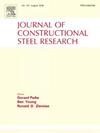Experimental study on crack propagation characteristics of welded high-strength steel Q690CFD joints
IF 4
2区 工程技术
Q1 CONSTRUCTION & BUILDING TECHNOLOGY
引用次数: 0
Abstract
High-strength steel typically refers to steel with a yield strength greater than or equal to 460 MPa. The heterogeneity caused by welding could impact the mechanical properties base material, weld metal and heat-affected zone. In this study, the welding sequence and crack propagation characteristics of welded high-strength steel joints were experimentally analyzed. It is found that the distribution of residual stresses in both the transverse and longitudinal directions exhibit highly nonlinear characteristics. The magnitude of longitudinal residual stresses can exceed 60 % of the nominal yield stress and the magnitude of transverse residual stresses can exceed 50 % of the nominal yield stress in the regions adjacent to the weld. In the early stage of crack propagation, the crack propagation rate in the HAZ and WM regions is significantly faster than in the base metal. The main differences in crack propagation between the base metal, weld metal, and HAZ occur in the initial and final stages of crack growth. In the stable crack propagation stage, there are no significant differences for the base metal, weld metal, and HAZ. Finally, a normalized crack growth prediction model was proposed with validated accuracy.
高强钢Q690CFD焊接接头裂纹扩展特性试验研究
高强度钢通常是指屈服强度大于或等于460兆帕的钢。焊接过程中产生的非均匀性会影响母材、焊缝金属和热影响区的力学性能。对高强钢焊接接头的焊接顺序和裂纹扩展特性进行了实验分析。研究发现,在横向和纵向上残余应力的分布都表现出高度非线性的特征。在靠近焊缝的区域,纵向残余应力的大小可超过公称屈服应力的60%,横向残余应力的大小可超过公称屈服应力的50%。在裂纹扩展初期,热影响区和软区裂纹扩展速率明显快于母材;母材、焊缝金属和热影响区裂纹扩展的主要差异出现在裂纹扩展的初始和最终阶段。在稳定裂纹扩展阶段,母材、焊缝金属、热影响区均无显著差异。最后,提出了一种归一化裂纹扩展预测模型,并验证了模型的准确性。
本文章由计算机程序翻译,如有差异,请以英文原文为准。
求助全文
约1分钟内获得全文
求助全文
来源期刊

Journal of Constructional Steel Research
工程技术-工程:土木
CiteScore
7.90
自引率
19.50%
发文量
550
审稿时长
46 days
期刊介绍:
The Journal of Constructional Steel Research provides an international forum for the presentation and discussion of the latest developments in structural steel research and their applications. It is aimed not only at researchers but also at those likely to be most affected by research results, i.e. designers and fabricators. Original papers of a high standard dealing with all aspects of steel research including theoretical and experimental research on elements, assemblages, connection and material properties are considered for publication.
 求助内容:
求助内容: 应助结果提醒方式:
应助结果提醒方式:


